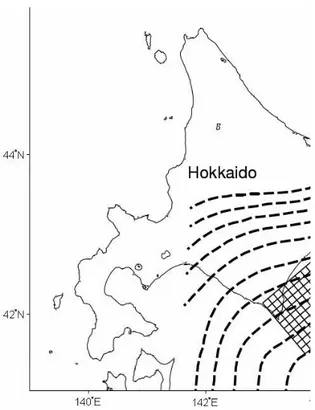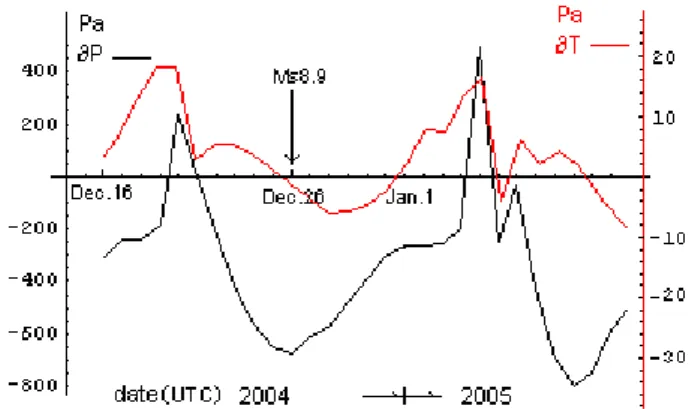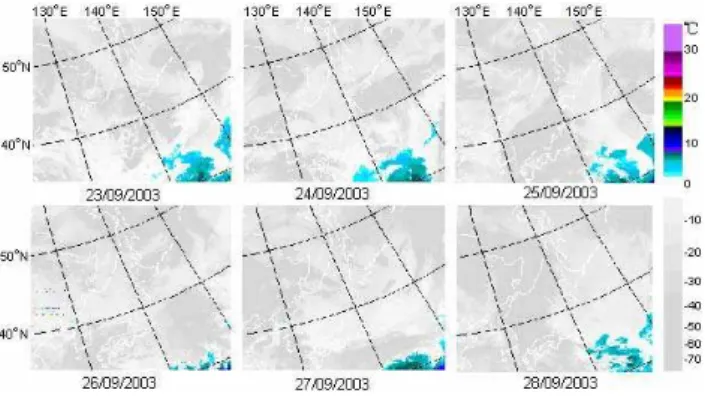1Beijing Normal University, Zhuhai Campus, 519085, China 2Zhejiang Normal University, Jinghua, 321004, China
Received: 23 April 2008 – Revised: 28 July 2008 – Accepted: 28 July 2008 – Published: 5 September 2008
Abstract. The paper introduced the model of the additive tectonics stress from celestial tide-generating force. The model can be used to explain the relationship between ad-ditive tectonics stress and seismic fault sliding. According to the periodic changes of the additive tectonics stress, the tem-perature is analyzes based on the temtem-perature data of NCEP (National Centers for Environmental Prediction) which are gathered for a period of time before and after the Hokkaido, Japan earthquake (25 September 2003). It is found that the abnormal increasing of the temperature is significantly asso-ciated with the seismic deformation, even if the epicenter was covered by the clouds. The effect of the additive tectonics stress on activities of the fault is to trigger it at a time when the stress level has already reached an advanced stage as in-dicated by the temperature increase. Based on this model, it is possible to forewarn short-impending earthquakes.
1 Introduction
Before the earthquake, the dynamic changes of the Earth’s surface temperature have aroused the concern of many re-searchers in the studying earthquake prediction (Mogi, 1982; Zhenwen, 1984). In 1988, the former Soviet Union scholar V. I. Gorny (1988), when studied earthquakes in Central Asia, found that large scale abnormal satellite infrared ther-mal fluctuations before many strong earthquakes in the area. Zongjin (1982) also found that there are abnormal warm-ing before the vast majority of the earthquakes when they did geothermal phenomenon investigation of the nine major earthquakes happened during the years from 1966 to 1976. An abnormally increased infrared temperature before an earthquake can reflect seismotectonic activities (Ouzounov et al., 2004).
Correspondence to:W. Ma (weiyuma@163.com)
Fig. 1.The epicenter of the 2003 Hokkaido earthquake determined by JMA (solid star). The dashed depth contours in km represent the upper boundary of the Pacific slab subducting under Hokkaido (Katsumata et al., 2004; Earthquake Research Committee, 2003).
However, how to identify the abnormal temperature changes before earthquakes confronts us with such a ques-tion as: in which period the reference background tempera-ture should be chosen.
Seismic movement within the Earth is a mechanical pro-cess and the Earth’s interior seismic tectonic activity is one of the most key internal factors of earthquake. However, the Earth is not an isolated celestial body and its running is affected by various factors from the cosmic environment, in which the astronomical tide is a major external factor of earthquake (McNutt et al., 1981; Heaton, 1975). In this pa-per, the model of Additive Tectonics Stress from Celestial Tide-generating Force (ATSCTF for short) is introduced to act as a new method to select the period in which the refer-ence background temperature can be chosen.
In this paper, the large earthquake in Tokachi-oki,(in Hokkaido,Japan) is the study object. The concise infor-mation about the earthquake is stated as follows: origin time=25/09/2003, UTC 19:50:06 (UTC: Coordinated Uni-versal Time); depth=27 km; moment magnitude (Mw)=8.1. In the region of Tokachi-oki, Hokkaido, the Pacific plate subducts toward N60◦W beneath Hokkaido from the Chishima (Kuril) trench at a rate of about 80 mm/year (DeMets et al., 1990). This earthquake is the largest event around the Japan islands after the Mw8.2Hokkaido Toho-oki earthquake in 1994. JMA (2003) located its epicenter above
Fig. 2.The additive tectonic stress of celestial tide-generating force on the seismic fault.
the subducting Pacific slab (41 46.78′N, 144 4.71′E; Fig. 1). The rest of the paper is organized as follows. Section 2 de-scribes the model of ATSCTF in details. In Sect. 3, through using the data from NCEP, the abnormally increasing evolu-tion of the temperature of the large earthquake occurred in Tokachi-oki is described. Section 4 concludes the paper.
2 The model of ATSCTF on seismic fault
2.1 How additive tectonics stress acts on seismic fault The gravity from celestial bodies, such as the Sun or the Moon, to the geocentric or any point within the Earth is de-fined as the celestial tide-generating force. When decom-posing the sum celestial tide-generating force of the Sun and the Moon to the main pressure (P-axis) and tension stress (T-axis), the additive tectonic stress –∂P and∂T can be worked out as showed in Fig. 2 (Weiyu et al., 2007). According to the process of earthquake, the direction which the additive tec-tonic stress on seismic fault and structural tectec-tonic activity field varies, so the direction of∂P and∂T varies, too. The additive tectonics stress acts on seismic fault can be classi-fied into the following five types by the directions of∂P’s and∂T’s changes (as shown in Fig. 2):
(1) Pressurization sliding: the directions of∂P’s and∂T’s changes are the same withP,T;
(2) Depressurization sliding: the directions of ∂P’s and
∂T’s changes are opposite toP,T;
(3) Pressurization and tension reducing sliding: the direc-tion of the∂P’s change is the same withP, but the di-rection of∂T’s change is opposite toT;
(4) Depressurization and tension increasing sliding: the di-rection of∂P’s change is opposite toP, but the direc-tions of∂T’s change are the same withT;
Fig. 3.The change of∂P,∂T in ATSCTF model.
Through above classification, there are three ways by which ATSCTF can enhance seismic fault sliding:
(1) The pressure increasing: increases the compressive stress and the shear stress in the fault plane, increases the fault tension until it reaches a critical state and in-duces an earthquake;
(2) The pressure reducing: not only reduces the positive stress of the fault plane, but also the friction of the fault plane, thereby, triggering the earthquake;
(3) Sometimes the pressure increasing and sometimes the pressure reducing: usually changes the unilateral force and breaks the balance of the fault plane, thereby releas-ing the energy already stored and triggerreleas-ing the earth-quake.
2.2 The using of ATSCTF model on the earthquake in Tokachi-oki, Hokkaido, 2003
Applying of the above model to analyze the additive tectonic stress of Tokachi-oki, Hokkaido from 29 August 2003 to 19 October 2003, a series of values of∂P and ∂T is worked out. Figure 3a shows the dynamics of∂P and∂T during that period, and there are three cycles. The relationship between the earthquake and its additive tectonic stress can be analyzed through the figure.
The directions of∂P and∂T’s change at the occurrence time of the earthquake were opposite to vector ofP,T. The effect of the ATSCTF on earthquake belonged to “Depres-surization sliding” type. This is similar to the earthquake of Indonesia on 26 December 2004 (Fig. 3b) (Weiyu et al., 2006). Both of them occurred on slow slip plate boundaries as showed in cycle “B” in Fig. 3a. According to ATSCTF model, the pressure reduces not only the positive stress of the fault plane, but also the rupture-slide intensity of the fault plane, then makes the fault stress status reach the critical point and advance the fault slide. During the three cycles, the earthquake occurred at the middle cycle when the addi-tive tectonic stress reaches a relaaddi-tively lower value but not, as usually expected, the time of turning point. It implied that
the accelerate action of the additive tectonic stress is succes-sive, and the instantaneous change of the additive tectonic stress didn’t spring the earthquake in suddenly but until the tectonic stress reach the critical broken point. In other two same cycles A and C, there are no earthquake occurred, for there are no temperature changes. It also indicated that the ATSCTF can’t induce the earthquake directly by itself, the decisive is seismotectonic activity. The progress of the fault activity can be reflected through the changes of temperature.
3 The evolution of abnormal increasing of the tempera-ture based on NCEP data
An infrared temperature abnormal increasing before an earthquake reflects seismotectonic activity (Ouzounov et al., 2004). However, when there are lots of clouds over the epi-center region, the temperature changing will not be recorded correctly. As showed in Fig. 4, different colors denote differ-ent temperatures. The white region means it was covered by clouds and the ground temperature can not directly be mea-sured. So it is impossible to get the accurate temperature changing under clouds.
Fig. 4. Brightness temperature images of FY-2 meteorological satellite of China (at 18:51 UTC) Note: The color bar in the right indicates the different temperature with Celsius scale.
It is very clearly showed in Fig. 5 that there is no abnormal temperature increase yet on 23 September 2003; On the 24th, an abnormal temperature increasing up to 5◦C appears in the south and the north of the future epicenter; On the 25th, an even higher temperature increase is recorded, reaching 7◦C and the lateral extent of the abnormally hot area increases significantly and the main earth shock occurred; On the 26th, the earthquake was over, the temperature decreased and the area of the anomaly became smaller; On the 27th, the perature anomaly has further shrunk; On the 28th, the tem-perature returned to its normal value. In addition, there are no comparable abnormal temperature changes in the other two cycles.
The observed temperature changing went through as such successive evolution: normal temperature→ original
tem-perature rising (on 24th)→reaching peak (main earth shock
on 25th 19 o’clock)→attenuation (after-shock on 26th and
27th)→return to its normal value (on 28th).
4 Conclusions
(1) The evolution of additive tectonics stress’ change im-plies that the tectonic stress build-up was correlated to the celestial tide-generating force. It did not suddenly cause the earthquake or induce it, but acted through a successive accelerating evolution.
(2) The time-spatial dynamic evolution images of NCEP temperature, which were extracted according to the cy-cle of the ATSCTF values displays the successive evo-lution: initial temperature increase → enhanced
tem-perature increase→intensification of the temperature
increase→peak of the temperature increase→
attenu-ation→return to baseline. This evolution of abnormal
temperature changing can clearly indicates the fault ac-tivities undertectonics stress: Tectonic movement ex-trusion→Rock micro-breakage→Energy
accumula-Fig. 5.Spatial-time evolution of abnormal temperature increase of NCEP images Note: the bar on the bottom is the temperature value with Celsius scale.
tion→Rock breaking enhancement→Energy release →Shaking→Tranquil.
(3) In the other two cycles of A, C in the ATSCTF, there are no such temperature changes as B cycle. That is to say, the tectonic stress intensity had not reached the critical state to shock, so there is no earthquake occurred. It implies that the celestial tide-generating force could in-duce the earthquake to occur when the tectonics stress on the active fault is in critical status.
Reviewed by: F. Freund and S. Mukherjee Edited by: M. Contadakis
References
An, Z. and Zhu, C.: Study of geothermal variations in relation to large earthquakes (1) – The distribution of thermal stresses in the neighborhood of the sharp end of an elliptical-shaped crack in an infinite elastic medium, Acta Seismologica Sinica, 6(2), 211– 222, 1984.
An, Z. and Zhu, C.: Study of geothermal variations in relation to large earthquakes (2) – The effect of temperature gradient on fracture propagation direction for strike-slip fault, Acta Seismo-logica Sinica, 6(4), 382–392, 1984.
DeMets, C., Gordon, R., Argus, D., and Stein, S.: Current plate motion, Geophys. J. Int., 101, 425–478, 1990.
Earthquake Research Committee, Long-term evaluation of earth-quakes along the Kuril trench, http://www.jishin.go.jp/main/ chousa/03 mar chishima/index.html, Headquarters for Earth-quake Research Promotion, Tokyo, 2003.
Gorny, V. I., Salman, A. G., Tronin, A. A., and Shilin, B. B.: The Earth outgoing IR radiation as an indicator of seismic activity, Proceeding of the Academy of Sciences of the USSR, 1988, 30(1): 67–69.
Heaton, T. H.: Tidal triggering of earthquakes, Geophys. J. R. Astr. Soc., 43(2), 307–326, 1975.
Indonesia magnitude 9.0. Earthquake Prediction, [M]: Koninkli-jke Brill NV, Leiden, The Netherlands, 61–68, 2006.
Ma, Z., Fu, Z., and Zhang, Z.: The nine biggest earthquakes in China 1966–1976, Seismics Press, Beijing, China, 1982. McNutt, S. R., Beavan, R. J.: Volcanic earthquakes at Pavlof
Vol-cano correlated with the solid earth tide, Nature, 294, 615–618, 1981.
96, 409–426, 2005.


